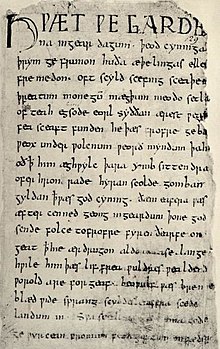Heorot

Heorot (/ˈh[invalid input: 'ay']ərɒt/ HAY-ə-rot), also Herot, is a mead-hall described in the Anglo-Saxon epic Beowulf as "the foremost of halls under heaven." It served as a palace for King Hroðgar, a legendary Danish king of the sixth century. Heorot means "Hall of the Hart" (male deer).[1] The Geatish (Swedish) hero Beowulf defends the royal hall and its residents from the demonic Grendel.
Description and symbolism
The anonymous author of Beowulf praises Heorot as follows:
Then, as I have heard, the work of constructing a building
Was proclaimed to many a tribe throughout this middle earth.
In time—quickly, as such things happen among men—
It was all ready, the biggest of halls.
He whose word was law
Far and wide gave it the name "Heorot".[2]
The men did not dally; they strode inland in a group
Until they were able to discern the timbered hall,
Splendid and ornamented with gold.
The building in which that powerful man held court
Was the foremost of halls under heaven;
Its radiance shone over many lands.[3]
The hall was large enough to allow Hroðgar to present Beowulf with a gift of eight horses, each with gold-plate headgear.[4] It functions both as a seat of government and as a residence for the king's thanes (warriors). Heorot symbolizes human civilization and culture, as well as the might of the Danish kings—essentially, all the good things in the world of Beowulf.[5] Its brightness, warmth, and joy contrasts with the darkness of the swamp waters inhabited by Grendel.[6]
Location of Heorot

Modern scholarship sees the village of Lejre, near Roskilde, as the location of Heorot.[7] In Scandinavian sources, Heorot corresponds to Hleiðargarðr, King Hroðulf's (Hrólfr Kraki) hall mentioned in Hrólf Kraki's saga, and located in Lejre. The medieval chroniclers Saxo Grammaticus and Sven Aggesen already suggested that Lejre was the chief residence of Hroðgar’s Skjöldung clan (called “Scylding” in the poem). The remains of a Viking hall complex was uncovered southwest of Lejre in 1986-1988 by Tom Christensen of the Roskilde Museum. Wood from the foundation was radiocarbon-dated to about 880. It was later found that this hall was built over an older hall which has been dated to 680. In 2004-2005, Christensen excavated a third hall located just north of the other two. This hall was built in the mid-6th century, all three halls were about 50 meters long.[6]
Fred C. Robinson is also convinced by this identification: “Hrothgar (and later Hrothulf) ruled from a royal settlement whose present location can with fair confidence be fixed as the modern Danish village of Leire, the actual location of Heorot.”[8] The most recent publication on Lejre and its role in Beowulf is by John Niles and Marijane Osborn, Beowulf and Lejre.[9]
In popular culture
- In the novel Grendel (1971), Heorot is referred to as "Hart" (male deer).
- In the video game Grendel's Cave, Heorot Hall is the starting location in the game and a safe place, except from the AI Monster Grendel, to sleep.
- The Heorot is a pub and draught house located on South Walnut Street in downtown Muncie, Indiana.
- Chi Heorot, a fraternity at Dartmouth College in Hanover, New Hampshire, is named after the hall.
- Heorot is the name of a short story set in the Dresden Files universe, a series of novels written by Jim Butcher.
- Herot is the primary setting of the TV series Beowulf: Return to the Shieldlands.
Science fiction references
- The Heorot series by Steven Barnes, Jerry Pournelle and Larry Niven is named after the hall. It contains the following books:
- The Legacy of Heorot (1987)
- Beowulf's Children (1995)
- The castle of Harrenhall in George R.R. Martin's A Song of Ice and Fire series is based on Heorot, and its attack and destruction.
- In The Sorrow of Odin the Goth, a story in Poul Anderson's book Time Patrolman, a fictional group of Goths migrate from the Vistula to the Dnieper and build a hall named Heorot, because "that was the name of a famous dwelling in the north".
Tolkien's usage
J. R. R. Tolkien, who compared Heorot to Camelot for its mix of legendary and historical associations,[10] used it as the basis for the Golden Hall of Rohan, Meduseld.[11]
References
- ^ "Kent place names - H", BBC Homepage. See under "Hartlip".
- ^ Beowulf, lines 74–79.
- ^ Beowulf, lines 306–11.
- ^ Beowulf, lines 1035–37
- ^ Halverson, John. "The World of Beowulf" ELH, Vol. 36, No. 4. (December 1969), pp. 593–608. JSTOR. Online Database. 6 December 2006.
- ^ a b Niles, John D., "Beowulf’s Great Hall", History Today, October 2006, 56 (10), pp. 40–44
- ^ Lapidge, Michael; Godden, Malcolm (1991). The Cambridge companion to Old English literature. Cambridge UP. p. 144. ISBN 978-0-521-37794-2. Retrieved 22 May 2010.
- ^ Robinson, Fred C. (1984). "Teaching the Backgrounds: History, Religion, Culture". In Jess B. Bessinger, Jr. and Robert F. Yeager (ed.). Approaches to Teaching Beowulf. New York: MLA. p. 109.
- ^ Niles, John; Osborn, Marijane (2007). Beowulf and Lejre. Arizona Center for Medieval and Renaissance Studies. ISBN 978-0-86698-368-6.
- ^ J. R. R. Tolkien, Beowulf: A Translation and Commentary (2015) p. 153
- ^ Tom Shippey, J. R. R. Tolkien (2001) p. 99
External links
- Baldwin, Stanley P., and Elaine Strong Skill. CliffsNotes on Beowulf. Cliffnotes, 2006.
- Kiernan, Kevin, Guide to Electronic Beowulf, 2003.

